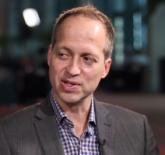Video


AT SABCS 2015
SAN ANTONIO – Women whose estrogen receptor–positive breast cancers have high expression of a DNA-mutating enzyme called APOBEC3B (A3B for short) are more likely to experience tamoxifen resistance, suggest data reported in a session and press briefing at the San Antonio Breast Cancer Symposium.
In a study of 285 women, the risk of progression or death on first-line tamoxifen was 67% higher for those whose primaries had high versus low expression of the enzyme, a DNA cytosine deaminase that is overexpressed in about half of all breast cancers.
Additionally, companion experiments in a xenograft breast cancer model showed that suppressing the enzyme delayed the development of tamoxifen resistance in tumors, whereas overexpressing it accelerated the development of resistance.
“High APOBECB3 expression levels correlate with poor outcomes for estrogen receptor–positive breast cancer, including recurrence during tamoxifen treatment,” said lead author Reuben Harris, Ph.D., an investigator at the Howard Hughes Medical Institute, professor at the University of Minnesota, Minneapolis, and member of the Masonic Cancer Center.
“One point to emphasize is that this is a gain-of-function mutating enzyme. A lot of things we hear about are loss of functions that are happening in cancer,” and at present, not much can be done about those, he said. But “because [APOBECB3] is an enzyme with an active site, I think that’s targetable.”
Dr. Harris drew an analogy between APOBEC mutagenesis and UV mutagenesis, noting that once the molecular mechanism was defined for the latter, interventions such as UV-blocking sunscreens and protective clothing were harnessed for prevention. “Now we have identified a significant source of mutation in breast cancer (as well as other cancers) and we can begin to think about innovations to control the mutating activity of this enzyme,” he elaborated.
Press briefing moderator and codirector of the San Antonio Breast Cancer Symposium, Dr. Carlos Arteaga, professor of medicine at Vanderbilt University, Nashville, Tenn,, and director of the Breast Cancer Program, asked, “Do you think this is ready to be addressed in the clinic? If you think so, can you speculate how we can do that?”
“I think it’s nearing readiness,” Dr. Harris replied. “We need more clinical studies. So far we’ve been focused on retrospective studies. … Some prospective studies need to be done. Obviously this needs to expand to include other treatments, and we also have to get a better handle on which subtypes are most affected by this mutagenic process.”
Previous research his team did in collaboration with their coinvestigators in the Netherlands showed that women with estrogen receptor–positive primary tumors treated only with resection had poorer progression-free and overall survival if their primaries had up-regulation of the A3B enzyme (Horm Cancer. 2014;5:405-13).
“This suggests that this is a prognostic marker for outcome, but we wanted to go further and ask if this process is contributing to or correlating with poor outcomes such as recurrence and resistance to tamoxifen therapy,” Dr. Harris commented.
In the new retrospective study, this time among women who experienced a recurrence of estrogen receptor–positive breast cancer and were then given first-line tamoxifen, the median progression-free survival was just 7.5 months for those with high A3B expression in the primary tumor, compared with 13.3 months for those with low expression (hazard ratio, 1.67; P = .0001).
“These are correlative studies that really suggest what many of the cellular experiments and genetic experiments in my lab and others have indicated, that this would be an adverse effector in estrogen receptor–positive breast cancer, but we wanted to test this hypothesis with a cause-and-effect experiment,” he said.
In xenograft experiments, they engineered estrogen receptor–positive MCF7L breast cancer cells to have either high or low expression of A3B and grew the cells into small tumors. They then grafted the tumors into female nude mice.
In a first set of experiments, knocking down expression of A3B slowed the development of tamoxifen resistance, and in fact, few tumors had become resistant to the drug even after a year, Dr. Harris reported. In a second set, overexpressing the enzyme in tumor cells by about 100-fold led to almost immediate tamoxifen resistance.
“So we can slow it down, and we can speed it up, and all of this is consistent with the clinical data indicating that those primary breast tumors that have high levels of this enzyme result in poorer outcomes than those tumors that have low levels,” he concluded.
As mutations induced by A3B might also affect the response to other treatments, ongoing research is now looking at its impact on the development of chemotherapy resistance, noted Dr. Harris.

